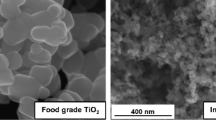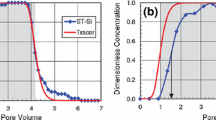Abstract
Nanoparticles are not specifically targeted in conventional treatment schemes; consequently, typical wastewater treatment systems are ineffective for nanoparticles removal. With rapidly increasing concern over their health effects, improved understanding of nanoparticle transport and retention in porous media filters is critical because of its application in new wastewater treatment methods and for assessment of the fate of the discharged nanoparticles in soil. In this study, a unique and robust integrated method is developed and validated. Experimentally, this approach uses an on-line, real-time, and in situ method for measuring nanoparticle retention dynamics, eliminating the laborious and less accurate sampling and off-line analysis. The data analysis part is a process simulator which provides both kinetic properties of the retention process as well as the overall capacity and loading. This technique is validated by application to the transport and retention of TiO2 nanoparticles in two vastly different porous filtration media—activated carbon and sand. TiO2 retained concentrations ranged from 0.24 to 0.37 mg g−1 for activated carbon and 0.01–0.014 mg g−1 for sand. The integrated method presented here is useful for both comparison of the filtration effectiveness of various porous materials as well as for process optimization and scale-up for industrial applications.




Similar content being viewed by others
References
Auffan M, Rose J, Bottero JY et al (2009) Towards a definition of inorganic nanoparticles from an environmental, health and safety perspective. Nat Nanotechnol 10:634–641
Ben-Moshe T, Dror I, Berkowitz B (2010) Transport of metal oxide nanoparticles in saturated porous media. Chemosphere 3:387–393
Boxall AB, Tiede K, Chaudhry Q (2007) Engineered nanomaterials in soils and water: how do they behave and could they pose a risk to human health? Nanomedicine 6:919–927
Chen GX, Liu XY, Su CM (2011) Transport and retention of TiO2 rutile nanoparticles in saturated porous media under low-ionic-strength conditions: measurements and mechanisms. Langmuir 9:5393–5402
Dunphy Guzman KA, Finnegan MP, Banfield JF (2006) Influence of surface potential on aggregation and transport of titania nanoparticles. Environ Sci Technol 24:7688–7693
French RA, Jacobson AR, Kim B et al (2009) Influence of ionic strength, pH, and cation valence on aggregation kinetics of titanium dioxide nanoparticles. Environ Sci Technol 5:1354–1359
Godinez IG, Darnault CJG (2011) Aggregation and transport of nano-TiO2 in saturated porous media: effects of pH, surfactants and flow velocity. Water Res 2:839–851
Handy RD, Shaw BJ (2007) Toxic effects of nanoparticles and nanomaterials: implications for public health, risk assessment and the public perception of nanotechnology. Health Risk Soc 2:125–144
Jeong SW, Kim SD (2009) Aggregation and transport of copper oxide nanoparticles in porous media. J Environ Monit 9:1595–1600
Kim HJ, Phenrat T, Tilton RD et al (2009) Fe-0 nanoparticles remain mobile in porous media after aging due to slow desorption of polymeric surface modifiers. Environ Sci Technol 10:3824–3830
Lecoanet HF, Wiesner MR (2004) Velocity effects on fullerene and oxide nanoparticle deposition in porous media. Environ Sci Technol 16:4377–4382
Lecoanet HF, Bottero JY, Wiesner MR (2004) Laboratory assessment of the mobility of nanomaterials in porous media. Environ Sci Technol 19:5164–5169
Lin DH, Tian XL, Wu FC et al (2010) Fate and transport of engineered nanomaterials in the environment. J Environ Qual 6:1896–1908
Singh SK (1998) Estimation of dispersion coefficient from data on soil column test. IX National Symposium on Hydrology, Amritsar
Solovitch N, Labille J, Rose J et al (2010) Concurrent aggregation and deposition of TiO2 nanoparticles in a sandy porous media. Environ Sci Technol 13:4897–4902
Tian YA, Gao B, Silvera-Batista C et al (2010) Transport of engineered nanoparticles in saturated porous media. J Nanopart Res 7:2371–2380
US EPA (2007) Nanotechnology whitepaper (EPA 100/b-07/001)
Acknowledgments
We would like to thank SRC/Sematech Engineering Research Center for funding this work. J. Rottman was supported by a graduate fellowship from the Intel Foundation.
Author information
Authors and Affiliations
Corresponding author
Rights and permissions
About this article
Cite this article
Rottman, J., Sierra-Alvarez, R. & Shadman, F. Real-time monitoring of nanoparticle retention in porous media. Environ Chem Lett 11, 71–76 (2013). https://doi.org/10.1007/s10311-012-0381-3
Received:
Accepted:
Published:
Issue Date:
DOI: https://doi.org/10.1007/s10311-012-0381-3




